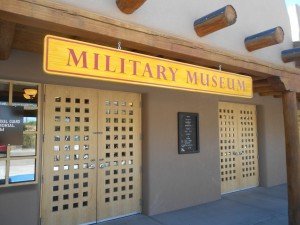
There is a small gem of a museum in Santa Fe New Mexico, operated by the New Mexico Guard which is a must stop for anyone interested in the military as well as the history of the New Mexico National Guard/ Militia. The Bataan Memorial Museum is one of the more interesting New Mexico museums…a one of a kind venue and a real trip into history, displays an enormous amount of genuine military artifacts from centuries past to today’s modern times. In addition to the amazing displays of uniforms, weapons, personal items, flags, patches, photos and more, the Bataan Museum also tells the story of the New Mexico National Guard/Militia from 1598 until today.
Thank you for reading this post, don't forget to subscribe!While this museum is named the Bataan Museum, the venue essentially honors the sacrifices made by the New Mexican’s in all U.S. wars. According to the museum, their goal is “to preserve the past, present and future of the New Mexico National Guard and to educate visitors about our proud history both in peace and war time”. The museum began as a tribute to the Veterans of the infamous Bataan Death March and has grown to showcase the contributions and sacrifices of soldiers in many theaters of war.
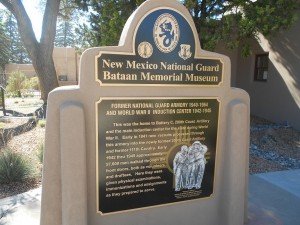
Displays include Civil War weapons and uniforms, Japanese and German military artifacts, flags and weapons, United States military weaponry and uniforms which not only span the earlier times of the 1800’s and the first half of the 1900’s but also through the Vietnam and Desert storm eras. Also included is a 1859 McCellan saddle, a WWI Harley Davidson motorcycle, a WWI freight wagon, a Korean War commemorative Thompson submachine gun, two AK-47 assault rifles, and much more.
You can also view the 24 minute video titled, The Tragedy of Bataan, which was developed in conjunction with PBS.
Bataan Memorial Museum Exhibits
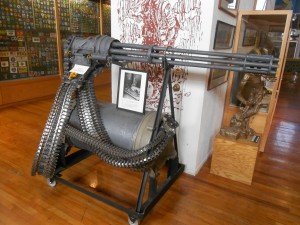
One fascinating exhibit inside the Bataan Museum is a M61A1 six barreled rotary cannon firing a variety of electrically primed 20mm cannon shells. This cannon was used by aircraft during the late 1950’s into the 1960’s. Weapons such as this were designed after the Second World War with the creation of the Air Force. It was widely recognized that military aircraft needed improved weapons systems. The M61A1 weapon largely replaced the Colt Mk. 12 20 mm gun. The Colt had good muzzle velocity but was known to jam, especially in a dogfight.
The M61A1 could be mounted either inside the aircraft or mounted outside on a pod. It has also been used on land based vehicles and trailers as essentially an anti-aircraft weapon. As you can see from the photos, the gun is quite a complex bit of engineering. The M61A1 can be driven hydraulically, electrically, or by ram air. The rate of firepower is between 4,000 and 7,200 rounds per minute.
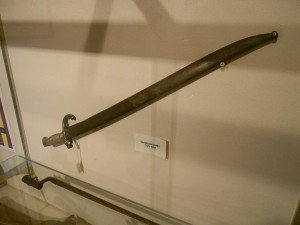
Another very interesting exhibit at the Bataan Memorial Museum is a collection of Civil War artifacts. The collection is large and impressive and includes a Civil War Bayonette Sword, a three inch cannon ball which was found at Glorieta Pass, twelve miles northeast of Santa Fe. The Battle of Glorieta Pass was the decisive Civil War battle in New Mexico which stopped and turned back the Confederate advance in the territory. Also featured in the Civil War collection is a Union Army cap.
The Bataan Death March
The Bataan Memorial Museum tells much about the story of what was referred to as the “Bataan Death March“. The Bataan Death March was one of the most brutal events during World War Two in the Pacific. The Japanese military captured and force marched 12,000 Americans and 68,000 Philippines from the island of Corregidor to northern Luzon. The prisoners were denied food and water and many stragglers were killed along the way. It is estimated that the Japanese killed about 1,000 Americans and more than 10,000 Philippine soldiers during the Bataan Death march. Many of those who did survive the initial march died later while being transported to Japan on what were called “hell ships”. It was beyond a doubt, one of the largest atrocities of World War Two.
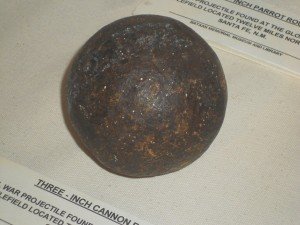
The New Mexico National Guard
The history of the New Mexico National Guard goes all the way back to 1598 as the Spanish militia. The citizen soldiers were involved in their particular vocation during the day and were ready to serve when called to duty. The New Mexico Guard units were involved during the Indian War campaigns of the old west as well as during the Civil War years. The two most significant battles of the Civil War was the battles of Valverde and Glorieta Pass. New Mexican units were also involved in the Spanish American War as part of Theodore Roosevelt’s Rough Riders.
In addition to the above, New Mexican Guard units were involved in General John Pershing’s pcampaign in Mexico against the forces of Poncho Villa. Their duty extended to World War One, World War Two, and Vietnam. The 188th Tactical Fighter Squadron of the New Mexico Air National Guard spent one year in Vietnam. New Mexico Guard units were also involved in the Desert Shield and Desert Storm actions in 1990-1991.
Two additional articles you’ll find interesting are the World War Two Sinking of the Robert E. Lee in the Gulf of Mexico and on our Western Trips site, the World War Two Defenses at Galveston Texas.
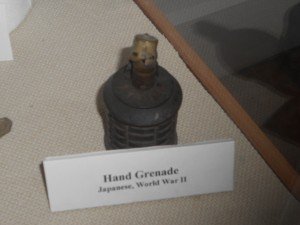
Visiting the Bataan Memorial Museum
The Bataan Memorial Museum is dedicated to the bravery and sacrifice of the 200th and 515th Coast Artillery regiments who fought at both Bataan and Corregidor until ordered to surrender to the much larger force of the Japanese Army. It should be noted that New Mexico’s World War Two involvement extended past the Philippines. New Mexico’s 804th Tank destroyer battalion and the 120th engineers battalion fought in Europe.
The Bataan Memorial Museum, operated by the New Mexico National Guard, is located at 1050 Old Pecos Trail in Santa Fe New Mexico. Admission is free and the hours are 10A-4P, Tuesday through Saturday. The location is just a very short drive south of the Santa Fe plaza in the direction of Museum Hill.
The Bataan Memorial Museum is an extraordinary museum and would be a great addition to your things to do in Santa Fe trip planner. When you’re deciding which of the many New Mexico museums to visit, be sure to add this one to your itinerary. Your stop there will be an interesting trip into history.
(Photos from author’s private collection)
